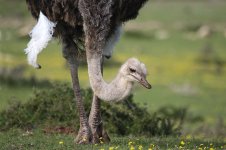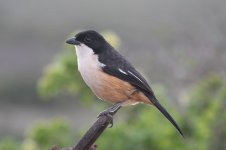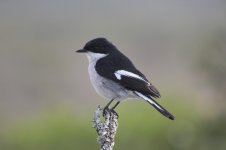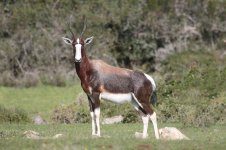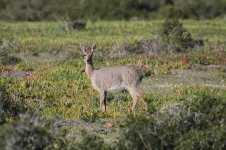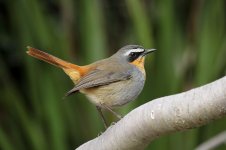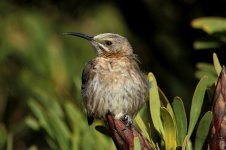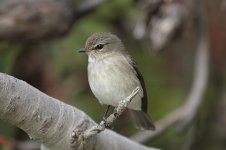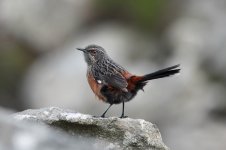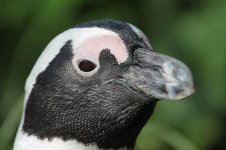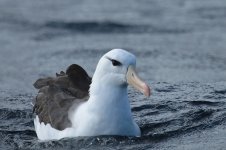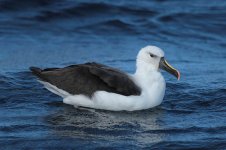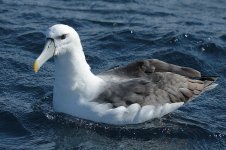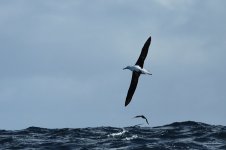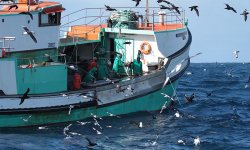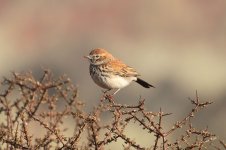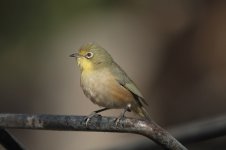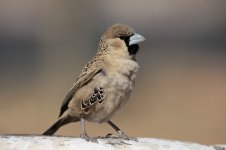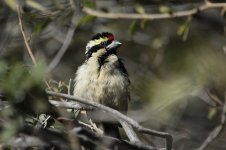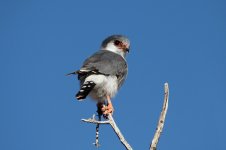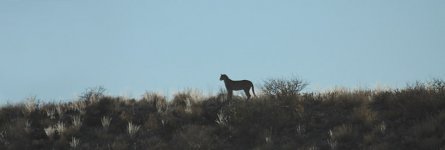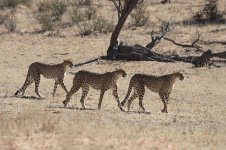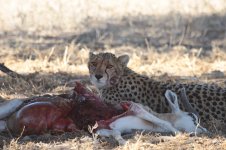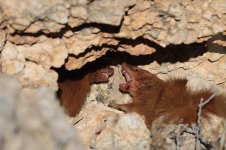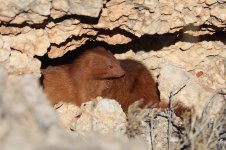13 July. Sir Lowry's Pass & the Cape Peninsula.
The following day I was due to embark on a pelagic into the waters south of Cape Town. One look at the conditions on this morning however suggested the trip was almost certainly going to be cancelled, winds blustering in from the east, the sea stormy and occasional squalls to liven things up. Darn, I thought, I'd only been hanging around the Western Cape for the previous week to await this sea trip!
Anyhow, back to the present, I quite fancied a Cape Rockjumper to kick the day off, so heading back along the N1, all too soon we were again climbing the roads to Sir Lowry's Pass, splendid views across False Bay and back to Table Mountain. On the brow of the ridge, though quite sunny, the wind was just incredible - a slip of the hand and I think the car doors would have blown all the way back to Cape Town!
What hope of seeing birds? Struggling again the wind, with occasional Orange-breasted Sunbirds making brave attempts to stay aloft, I soon understood I would need to climb to the summit and drop down to the hopefully sheltered western side. And that I did, majestic White-necked Ravens playing on the wind as I struggled to remain upright, a pair of Sentinel Rock Thrushes on one of the upper slopes. And, just as I had hoped, in the immediate lea of the summit, a broad ledge of grass and rock where the wind barely russled the blades, bliss. Here would be my birds.
Five minutes later, I was perched on a rock with my quarry hopping and scurrying about in front, no less than five Cape Rockjumpers in all their glory, one even popping up just a few metres in front! Nice. Also Cape Bunting and several Familiar Chats. And then a glance to the east, 'oh crap', I muttered, the blackest of black skies racing in to obliterate the sun. No hope of getting back to the car I understood, the rain was just minutes away. I darted around the rocks, found a cubby hole and slunk inside, just in time! Down it came, a wild mix of rain and hail, the wind going sideways even in this sheltered spot. Warm and cozy in my hole, I sat it out, the storm fortunately only lasting ten minutes. And then I legged it all the way back to the car, flushing a Cape Grassbird en route and arriving back at the car to the smirks of my companion who had again decided a book was preferable to masochism on a mountain.
For the rest of the day, almost entirely sunny, we opted for a pleasant tour of the Cape Peninsula, the main stops being for a waddle with the African Penguins at Simon's Town, a short seawatch over False Bay (White-chinned Petrel and Subantarctic Skua the highlights) and a stroll in the mountains of the interior, the last producing Verreaux's Eagle, Cape Siskin and loads more Orange-breasted Sunbirds. Other highlights were coffee in Kommetjie, all four species of cormorant, six Black Oystercatchers and, naturally, the stunning landscapes throughout.
Back in Cape Town, the inevitable news - no chance of the pelagic next day, winds forecast to batter on incessantly. Maybe the following day, they said.
14 July. Kirstenbosch & Rooi Els
With the pelagic cancelled, though still possible for the following day, I toyed with the idea of just cutting and running, the lure of the Kalahari most tempting. However, I eventually settled on the option to kill a day in the Cape Town area and gamble that the weather might calm down.
Splitting up for the day, my partner in crime had desires for Great White Sharks in Gans Bay, the cage diving experience that offers the chance to virtually tickle the noses of these super predators. Being a total scrooge, I however opted for a far more sedate alternative, a day of leasure in the Kirstenbosch botanical gardens, the idea being to photograph Cape Sugarbirds.
On the slopes of Table Mountain, Kirstenborsch is one of the world's great botanical gardens, an impressive floral mix of alloes, proteas and ericas set between manicured lawns and an extensive network of paths and trails. Eyes up, towering ramparts of Table Mountain rising to the sky; eyes down, birds flitting in each and every direction. Entering the gardens, birds are immediately apparent - Cape Francolins, Hadeda Ibis and Helmeted Guineafowl on the lawns, Cape Bulbuls and Cape Robin-Chats in the flowering beds, Southern Double-collared Sunbirds at every other flowerhead. A short stroll through indigenous forest and thick undergrowth along the Braille Trail added the first flocks of Cape White-eyes, plus Sombre Bulbul, Dusky Flycatcher and, after a bit of searching, a Lemon Dove. Eight Olive Pigeons also seen in adjacent tall trees.
As I meandered up through the gardens I eventually reached the protea gardens - plenty of time spent here, a Rufous-cheeked Sparrowhawk one of the highlights, Swee Waxbills and Forest Canaries amongst the others, plus very photogenic Dusky Flycatchers and Cape Robin-Chats. However, despite quite a number of circuits, I spectacularly managed not to see a single Cape Sugarbird, a species normally quite common here. Eventually I gave up and, as midday approached and the gardens began to attract more and more general tourists, I decided to leave.
Still keen on photographing some Cape Sugarbirds, I then travelled round to the far side of False Bay to try my luck on the coastal fynbos at Rooi Els, another of the Cape's very spectacular stretches of coastline. A very good move this turned out to be, not only did I find a flock of eight Cape Sugarbirds almost immediately, but one just sat on a protea in the sunshine and posed for pictures just a few metres away, my photographic desires duly satisfied. Plentiful Orange-breasted Sunbirds also present, plus a Cape Grassbird, three Cape Siskins, a Fiscal Flycatcher and, on the cliffs above, one Verreaux's Eagle.
For day that was spent 'killing time', I was most content, a Klipspringer on departure adding to the contentment, a troop of Baboons also seen, plus Cape Fur Seals in the sea adjacent. Back in Cape Town, good news all around - my friend had not been chomped by the Great White Sharks and, better still, all was go-go for the pelagic next day!





